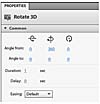- Creating a Button to Trigger a Transition
- Adding Artwork
- Creating a New State for the Transition
- Adding an Action in the Timeline
- Testing and Exporting to SWF
- From Here
Adding an Action in the Timeline
The Flash Catalyst Timeline can be used to add and define an action to enhance our transitions between pages.
- In the Timelines panel, click the triangle next to State Transitions to expand both transitions (Page 1 > Page 2 and Page 2 > Page 1).
- With the Page 1 > Page 2 transition selected in the first column of the Timeline, click the circle in the artboard to select it. This is the artwork to which the new action will be applied.
- Click the down arrow next to Add Action (at the bottom of the Timeline). Choose Rotate 3D from the pop-up list of options (see Figure 7).
- With the action defined, pause to notice the options in the Properties panel for the Rotate 3D action. You can set "to" and "from" angles for the x, y, and z axes. You can also specify the duration of the action, add a delay, and experiment with the additional effects available in the Easing pop-up. However, it's often easier and more intuitive to define any action durations right in the Timeline. Try it now: Click in the Timeline and drag to extend the duration to one second (1 s), as shown in Figure 8.
- Next, we'll add 3D rotation to the transition from page 2 to page 1. Select the Page 2 > Page 1 row in the Timeline. The circle should still be selected. (If it somehow became deselected, select it again.) Add a Rotate 3D action and extend the duration to one second.
Figure 7 Adding 3D rotation.
Figure 8 Setting the duration of an action.
Change the y-axis rotation from 360 to 0 (see Figure 9). With this setting, the rotation from page 2 to page 1 will be in the opposite direction of the rotation from page 1 to page 2.

Figure 9 Defining y-axis rotation.